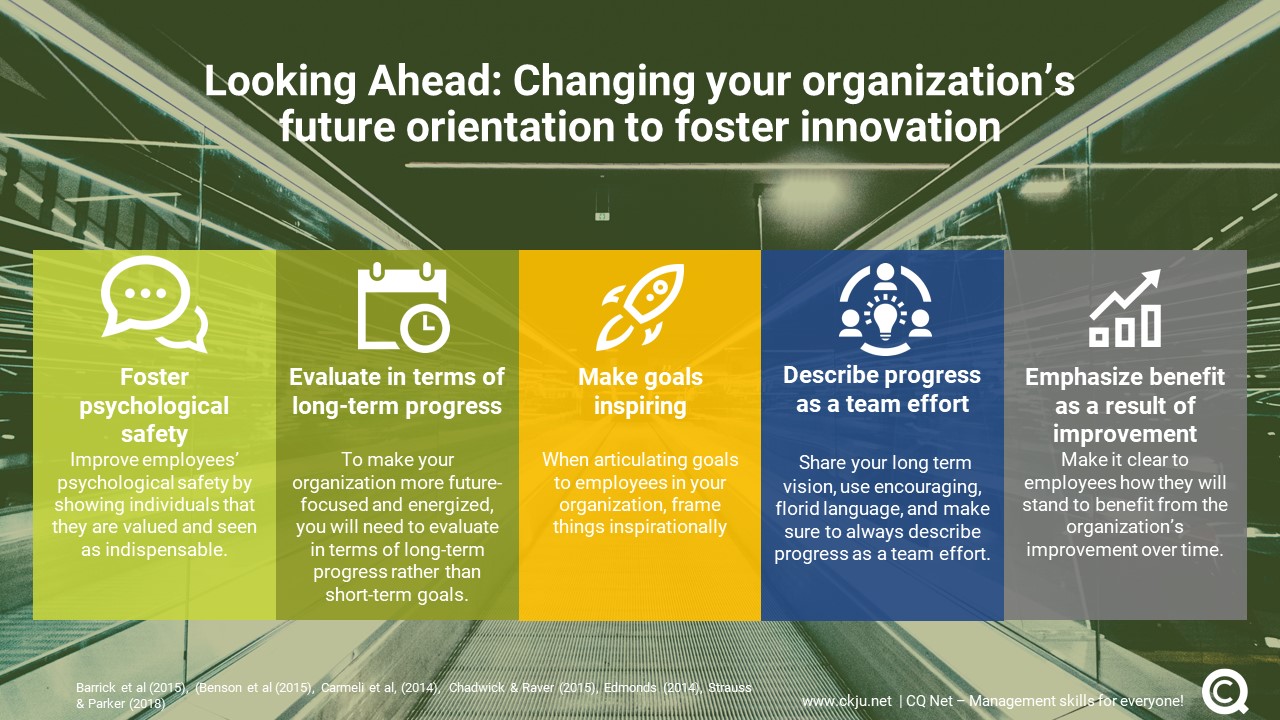- All Management Learning Resources
- Changing future orientation

Executive summary
Is it time to reorient your organization’s outlook? Are you company’s goals too short-term and reactive, rather than far-reaching and proactive? Does it feel as though people are always scrambling to deal with emergencies and “put out fires”, when ideally your organization would be taking carefully planned steps? For these, or many other reasons, it may be time for you to shift how your organization sets goals, and how members of your organization consider the future. In this CQ Dossier we have a look at how you can change your organization's future orientation to foster innovation.
Contents
- Executive summary
- Future orientation defines how an organization considers its long-term prospects, goals, and future
- A lack of future orientation leads to excessive focus on temporary outcomes rather than big ideas
- Develop and commit goals that reflect your organization’s future orientation
- Involve employees in shaping your organization’s future orientation
- Make sure your organization keeps looking ahead
- Key take-aways
- References and further reading
Future orientation defines how an organization considers its long-term prospects, goals, and future
Whether your organization is changing in its goals, responding to seismic shifts in the industry, or working to take a more long-term approach, it may be time for you, as a manager, to work to shift the future orientation in a useful way. The term future orientation refers to how employees of an organization, management, and the organization as a whole considers its long-term prospects, goals, and future. When an organization takes on an empowered, expansive future orientation, innovation tends to blossom and growth is easier to accomplish (Seijts, 1998). Below is a review of the latest scientific research on changing – or improving – the future orientation of your organization.
A lack of future orientation leads to excessive focus on temporary outcomes rather than big ideas
Often, an organization’s future orientation arises organically, as a result of how business is done on a day-to-day basis. However, this can result in an excessive focus on temporary outcomes rather than big ideas (Aroles & McLean, 2016). If an organization is always “fighting to survive” in a challenging economic landscape, members of the organization may develop an outlook that is short-term and survivalist in nature. Such an approach is typically resistant to risk and change, with very little support for mold-breaking innovation or challenging ideas. This can, paradoxically, keep the organization functioning in a mediocre way, always fighting to survive.
Develop and commit goals that reflect your organization’s future orientation
As a manager, you must work to help define your goals, and broadcast those goals to the team. The first step is consulting with management and leadership within the organization, and working to come to an agreement about what your ideals and long-term focus should be (Linder & Foss, 2018).
- Do you want your organization to lead its field, in terms of invention and disruption?
- How much growth do you expect to experience in the next five or ten years?
- In which ways will your organization distinguish itself from competitors?
- What sectors will your organization have a competitive presence in, ten years in the future?
Such discussions may take months before you arrive at a consensus. At the end of the process, you and others in leadership should be in agreement regarding what makes your organization distinctive, what aspects of the organization should grow and thrive in the coming years, and what your organizations long-term plans are (Cameron & Green, 2015). These plans should be framed positively, in terms of what your organization will gain, and how it will improve. Once a dynamic, encouraging, future-focused plan has been developed, it is time to share it with your team.
Management skills newsletter
Join our monthly newsletter to receive management tips, tricks and insights directly into your inbox!
Involve employees in shaping your organization’s future orientation
The lower an employee is in the hierarchy, the less likely they are to be invested in their organization’s future. From the perspective of the employees, this is rational – if you’re not sure you will be with a company for the long haul, it is hard to prioritize the organization’s success. This outlook can quash productivity and result in a workforce that is self-protective and self-interested. However, inspirational, effective managers can reach these employees and give them a sense of personal involvement in their company’s future, helping to boost motivation, innovation, and collaboration in the process (Strauss & Parker, 2018).
Foster psychological safety
One way to boost employees’ involvement in the organizations future is by helping them to feel more secure and safe within the workplace. In organizational research, psychological safety refers to how secure an employee feels in their job (Barrick et al, 2015). A psychologically safe employee trusts that they will not be fired for airing opinions or for taking reasonable risks. Psychological safety is a strong predictor of attachment and commitment to an organization.
As a manager, you can improve employees’ psychological safety by showing individuals that they are valued and seen as indispensable (Carmeli et al, 2014). Make sure that regular employee reviews highlight the contributions people have made – and consider using formal recognition of accomplishments, such as financial bonuses or company-wide awards. Work with employees who challenge you in an appropriate way – and encourage respectful dissent and questioning. The more trusted and secure employees feel in the workplace, the more likely they are to see the organization as a place they have a future with.
Evaluate in terms of long-term progress
To make your organization more future-focused and energized, you will need to evaluate in terms of long-term progress rather than short-term goals. Employees often assess their own performance in terms of short-term benchmarks and quarterly figures, fearing that if they do not meet the mark at all times, they will be let go. However, if your organization is going to truly look forward, you as a manager must cast your gaze farther ahead. If employees are streamlining processes, creating new ideas, growing their skills, and helping the organization have long-term success, missing a few short-term quotas or productivity benchmarks should be tolerated (Chadwick & Raver, 2015).
Make goals inspiring
When articulating goals to employees in your organization, frame things inspirationally (Edmonds, 2014). As you discuss the organization’s progress, talk about it in terms of what the group will achieve together, not what is needed from employees.
Describe progress as a team effort
Help employees to feel that they are part of a larger movement – share your long term vision, use encouraging, florid language, and make sure to always describe progress as a team effort.
Emphasize employees' benefit as a result of improvement
Present your new, future-focused outlook as a source of growth and motivation, and make it clear to employees how they will stand to benefit from the organization’s improvement over time.
Make sure your organization keeps looking ahead
When a new process or system is introduced at work, there is typically a period of improved outcomes, followed by a period of backsliding. It can be easy to meet new goals and adhere to new processes for a while, but as people get acclimated, they tend to slip into their old habits. This can happen with a future orientation, too – a team may begin with a positive, long-term-focused outlook, but then slide back into old patterns of working on short-term goals and putting out “fires”, as time wears on.
Re-energize people who have lost their motivation
When an organization is adapting to change, management must take steps to keep everyone focused and re-energize people who have lost their motivation and positivity (Kotlar et al, 2018). One way to do this is by re-orienting employees on a regular basis. Meetings about long-term goals should occur on a semi-regular basis, and should remind employees of where your organization is headed, and all it has accomplished so far. Again, the key is to frame these reminders positively, so team members do not feel reprimanded.
Evaluate progress with blend of process and outcome measures
When monitoring your organization’s progress, make sure to use a blend of process and outcome measures. Employees are resistant to perceived quotas– they can feel like a threat of punishment. Instead, discuss how you’d like to see the organization doing business, and how you’d like processes to change and become more future-focused. Evaluate teams and employees in terms of their processes and their meticulousness – not in terms of delivering temporary results (Benson et al, 2015).
Balance expressing gratitude and correcting behavior
Place just as much energy into expressing gratitude and encouragement for achievements as you do into correcting behavior that needs to be improved. As employees acclimate to this way of being evaluated, they will come to see themselves as vital members of a vibrant organization with a promising future – and they will become more and more personally invested in making that future a reality.
Key take-aways
- Focusing on long-term goals can boost motivation and help make an organization more distinctive and innovative.
- Future goals should be articulated and agreed upon by an organization’s leadership, then broadcasted to all employees.
- When employees feel secure and valued within their organization, they have an easier time involving themselves in long-term goals.
- To keep your team focused on the future, hold regular re-orientations where achievements are celebrated and your long-term outlook is reaffirmed.
- Evaluate employees in terms of their work processes, not their short-term outcomes.
References and further reading
Aroles, J., & McLean, C. (2016). Rethinking stability and change in the study of organizational routines: Difference and repetition in a newspaper-printing factory. Organization Science, 27(3), 535-550.
Barrick, M. R., Thurgood, G. R., Smith, T. A., & Courtright, S. H. (2015). Collective organizational engagement: Linking motivational antecedents, strategic implementation, and firm performance. Academy of Management journal, 58(1), 111-135.
Berson, Y., Halevy, N., Shamir, B., & Erez, M. (2015). Leading from different psychological distances: A construal-level perspective on vision communication, goal setting, and follower motivation. The Leadership Quarterly, 26(2), 143-155.
Cameron, E., & Green, M. (2015). Making sense of change management: A complete guide to the models, tools and techniques of organizational change. Kogan Page Publishers.
Carmeli, A., Sheaffer, Z., Binyamin, G., Reiter‐Palmon, R., & Shimoni, T. (2014). Transformational leadership and creative problem‐solving: The mediating role of psychological safety and reflexivity. The Journal of Creative Behavior, 48(2), 115-135.
Chadwick, I. C., & Raver, J. L. (2015). Motivating organizations to learn: Goal orientation and its influence on organizational learning. Journal of management, 41(3), 957-986.
Edmonds, S. C. (2014). The culture engine: A framework for driving results, inspiring your employees, and transforming your workplace. John Wiley & Sons.
Kotlar, J., Massis, A., Wright, M., & Frattini, F. (2018). Organizational Goals: Antecedents, Formation Processes and Implications for Firm Behavior and Performance. International Journal of Management Reviews, 20(S1).
Linder, S., & Foss, N. J. (2018). Microfoundations of organizational goals: a review and new directions for future research. International Journal of Management Reviews, 20(S1).
Seijts, G. H. (1998). The importance of future time perspective in theories of work motivation. The Journal of Psychology, 132(2), 154-168.
Strauss, K., & Parker, S. K. (2018). Intervening to enhance proactivity in organizations: Improving the present or changing the future. Journal of Management, 44(3), 1250-1278.
About the Author







